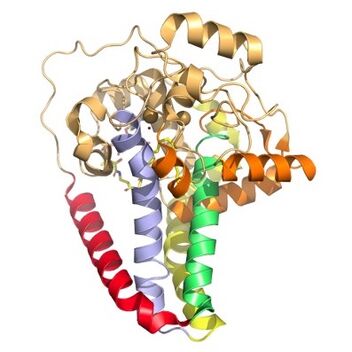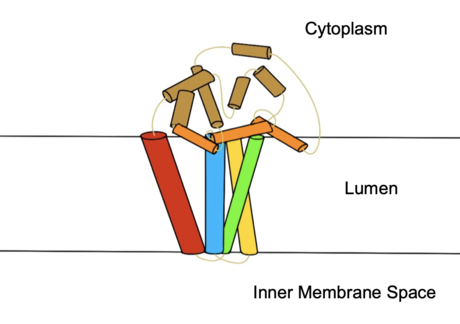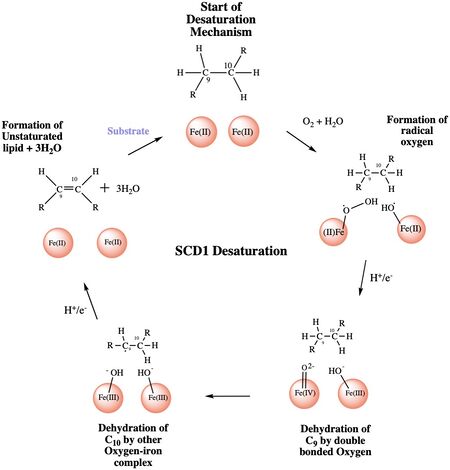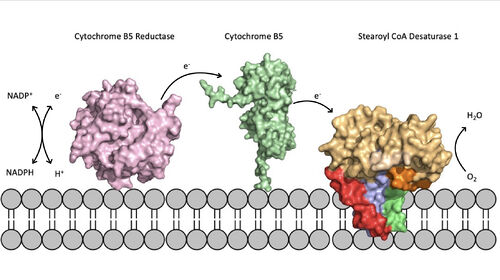User:Jacob Holt/Sandbox 1
From Proteopedia
(Difference between revisions)
| Line 40: | Line 40: | ||
| + | === Substrate Entering and Leaving === | ||
| + | The substrate enters the active site through the active site tunnel and undergoes a <scene name='87/877552/Substrate_entry_exit/4'>conformational change</scene> to conform to the kinked shape of the tunnel<ref name="Bai" />. Upon the substrate being converted to its final form, the product is laterally released from the protein due to a lateral egress of H1 and H2 caused by the deformation in the hydrogen bonding of the residues N 143 and T 257<ref name="Bai" />. | ||
| + | === Catalytic Molecule === | ||
| + | The <scene name='87/877552/Water/4'>catalytic molecule</scene> of the SCD1 enzyme is a water molecule, coordinated by <scene name='87/877552/Asparagine_h20_stabilization/3'>N 261</scene> via hydrogen bonding<ref name="Bai" />. The water molecule is 2.2 Å away from the Fe2+ metal ion molecule<ref name="Bai" />. It interacts with the Fe2+ ion to make highly reactive radicals that are able to desaturate the highly stable carbon chain<ref name="Yu">DOI:10.1021/acscatal.9b00456 </ref>. It is through the coordination of these ions by the histidines that the <scene name='87/877552/Diiron_center/9'>substrate and catalytic molecule</scene> are able to be positioned within the vicinity of carbons 9 and 10 of the ligand<ref name="Yu" />. | ||
=== Ligand Binding Pocket and Histidine Coordination === | === Ligand Binding Pocket and Histidine Coordination === | ||
| - | The ligand binding pocket is a narrow tunnel that extends approximately 24 Å into the mostly hydrophobic interior of the protein. The ligand is stabilized by bending into a kinked conformation which creates a tight fit in the binding pocket tunnel, and by a hydrogen bond that occurs between the <scene name='87/877552/W258/ | + | The ligand binding pocket is a narrow tunnel that extends approximately 24 Å into the mostly hydrophobic interior of the protein. The ligand is stabilized by bending into a kinked conformation which creates a tight fit in the binding pocket tunnel, and by a hydrogen bond that occurs between the <scene name='87/877552/W258/3'>W 258</scene> side chain and the acyl carbonyl<ref name="Bai" />. The kink in the tunnel is formed by the conserved residues, <scene name='87/877552/Desaturation_site/10'>T 257 and W 149</scene> which are stabilized by the hydrogen bond shared with Q143<ref name="Bai" />. There are <scene name='87/877552/Substrate_orientation_w_fe/7'>two Fe2+ ions</scene> that interact with the substrate; the Fe2+ ions are coordinated by <scene name='87/877552/Histidine_coordination/8'>9 invariant histidine residues</scene>. <scene name='87/877552/Substrate_oreintation_fe_90deg/4'>When rotated 90 degrees</scene> the ligand is seen to be in a eclipsed position, indicating it is in its post-reaction form. One metal ion is coordinated by 4 histidines residues and a water molecule, and the other metal ion is coordinated by 5 histidine residues<ref name="Bai" />. The histidine residues position the metal ions 6.4 Å apart<ref name="Bai" />. |
=== Desaturation Site === | === Desaturation Site === | ||
| Line 51: | Line 55: | ||
=== Active Site Cap === | === Active Site Cap === | ||
The two conserved residues of the active site cap are <scene name='87/877552/Active_site_cap/8'>Y 104 and G 287</scene>. These two residues form a hydrogen bond creating a rigid barrier at the end of the active site to keep the ligand from moving during the reaction<ref name="Bai" />. The active site cap is also used in determining the substrate length when entering the active site<ref name="Bai" />. | The two conserved residues of the active site cap are <scene name='87/877552/Active_site_cap/8'>Y 104 and G 287</scene>. These two residues form a hydrogen bond creating a rigid barrier at the end of the active site to keep the ligand from moving during the reaction<ref name="Bai" />. The active site cap is also used in determining the substrate length when entering the active site<ref name="Bai" />. | ||
| - | |||
| - | === Catalytic Molecule === | ||
| - | The <scene name='87/877552/Water/4'>catalytic molecule</scene> of the SCD1 enzyme is a water molecule, coordinated by <scene name='87/877552/Asparagine_h20_stabilization/3'>N 261</scene> via hydrogen bonding<ref name="Bai" />. The water molecule is 2.2 Å away from the Fe2+ metal ion molecule<ref name="Bai" />. It interacts with the Fe2+ ion to make highly reactive radicals that are able to desaturate the highly stable carbon chain<ref name="Yu">DOI:10.1021/acscatal.9b00456 </ref>. It is through the coordination of these ions by the histidines that the <scene name='87/877552/Diiron_center/9'>substrate and catalytic molecule</scene> are able to be positioned within the vicinity of carbons 9 and 10 of the ligand<ref name="Yu" />. | ||
| - | |||
| - | === Substrate Entering and Leaving === | ||
| - | The substrate enters the active site through the active site tunnel and undergoes a <scene name='87/877552/Substrate_entry_exit/4'>conformational change</scene> to conform to the kinked shape of the tunnel<ref name="Bai" />. Upon the substrate being converted to its final form, the product is laterally released from the protein due to a lateral egress of H1 and H2 caused by the deformation in the hydrogen bonding of the residues N 143 and T 257<ref name="Bai" />. | ||
| - | |||
| - | |||
== Proposed Mechanism == | == Proposed Mechanism == | ||
Revision as of 14:46, 27 April 2021
Desaturation of Fatty Acids using Stearoyl-CoA Desaturase-1 Enzyme
| |||||||||||
Student Contributions
Carson Maris, Jess Kersey, Jacob Holt





